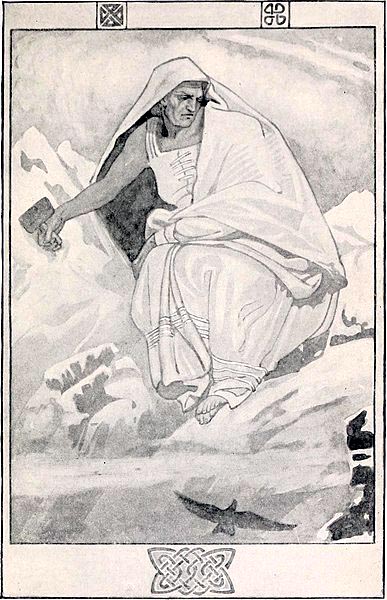 |
| The Cailleach (Wikipedia) |
Note: Many of our "fun" or "silly" traditions actually have their roots in something ancient and serious. So it is with Groundhog Day, celebrated in the U.S. on February 2.
Get Ready: Do you know what happens on Groundhog Day? Did you see the movie by that name?
You may have heard of Punxsutawney Phil, the fortune-telling groundhog whose shadow on February 2 foretells six more weeks of winter. He was one of the stars of the 1993 comedy hit Groundhog Day, and has been famous in the state of Pennsylvania and across the United States since at least 1840.
February 2 is a "light" holiday in the Catholic Church, called "Candlemas," and there has been lots of weather lore associated with it, going back to the days of Rome. It is halfway between the northern hemisphere's winter solstice--the shortest day of the year--and the spring equinox. In may places, the earth is noticeably beginning to "wake up."
Many animals have fulfilled the role Phil plays in Pennsylvania: bears (which hibernate in dens), and later, when they became scarce, badgers (which live in a burrow, similar to groundhogs). Foxes, too, and hedgehogs. All of these spend at least part of their time underground.
Most peculiarly, a Scottish poem speaks of the Feast of St. Bridget (also called Bride), which is also on February 2. "The serpent will come from the hole," it says, "On the brown Day of Bride"; the dreariness ("brown") indicates winter is over even "Though there should be three feet of snow / On the flat surface of the ground."
But what do burrow-dwelling critters have to do with a wood-gathering witch?
This question is tied to a bigger one. The groundhog's shadow indicates a sunny day, yet winter will last longer. Many people wonder: if it's sunny, shouldn't that indicate winter is over?
Part of the answer lies in the story of a witch with many names, but often called in Gaelic the Cailleach. Although in the Scots tongue her name simply means "old woman," she is much, much more. She is said to be mother to all the goddesses and gods. It is even said that the mountains were formed by her, sometimes with the use of a giant hammer. And to many, she is the Queen of Winter.
The Cailleach sleeps through the summer, they say, and can stay awake through the winter only as long as she has firewood. So if, when she goes out gathering wood on February 2, the weather is dark and dreary, she can only find a little wood, and winter will end sooner. But if she can see well (like on a bright sunny day), she can gather more, and winter will last longer.
--------Read more: https://en.wikipedia.org/wiki/Cailleach
Practice: Match the term to its definition below:
- associated (with)
- burrow
- dens
- dreary
- fulfilled
- hibernate
- role
- scarce
- serpent
- tongue
- a hole or tunnel in the ground where animals live
- sleep through the winter
- brought to realization
- not commonly found
- connected (with); related (to)
- a language
- dull; not bright and cheerful
- a part played by a character in a story
- caves in the side of a hill where animals live
- another word for snake
Answers are in the first comment below.
Submitted to the Shenzhen Daily for February 2, 2021


Answers to the Practice: 1. e; 2. a; 3. i; 4. g; 5. c; 6. b; 7. h; 8. d; 9. j; 10. f
ReplyDelete